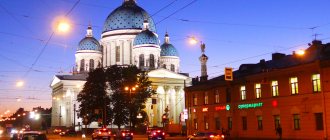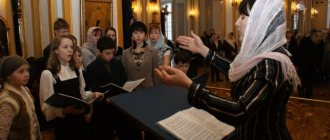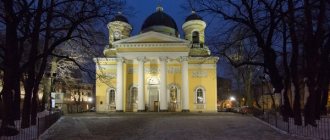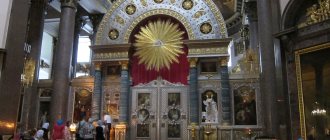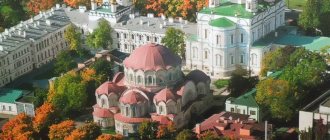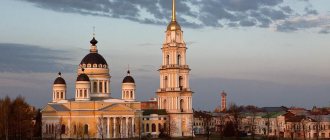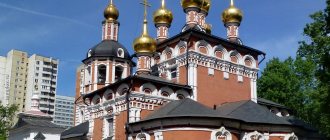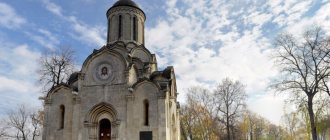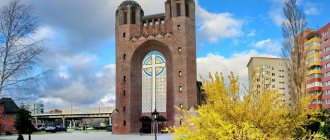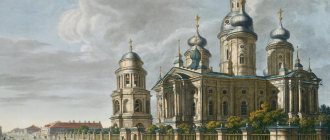Perhaps you are looking for information about: Smolny (cradle of the revolution / Smolny Institute / residence of the governor of St. Petersburg)
The Smolny Cathedral in St. Petersburg is located on the left bank of the Neva, in the Smolny Dvor area, in the place where resin was boiled for making ships. The temple is part of the architectural ensemble of the Smolny Monastery. Built in Baroque style. The architecture of the ensemble organically combines elements of ancient Russian architecture and European architecture.
Where is the Resurrection Smolny Cathedral located in St. Petersburg
The cathedral is located in a picturesque place, chosen by Elizabeth herself: on the left bank of the Neva, not far from her native palace. Now you can find it on Rastrelli Square, 1.
The palace got its name because of its location. Previously, the production of resin for ships was organized there. Tradition says that Elizaveta Petrovna, in her youth, decided to end her life in a quiet monastery, but this was not destined to happen. She chose a place for the monastery not far from her home palace.
Belfry
Today, not only the temple, but also the belfry of the cathedral is open to everyone. The belfry houses the highest observation deck in St. Petersburg - its height is 50 meters. The staircase to it is located to the right of the entrance to the cathedral. First you will have to walk about 280 steps along the usual wide staircase, then you will have to climb the spiral and hanging staircases.
The observation deck offers views of the city. From here you can see the Bolsheokhtinsky Bridge, the Church of Saints Zechariah and Elizabeth, the government building and Rastrelli Square, as well as the Kikina Palata square.
Spiral staircase to the belfry of the cathedral, © Tatyana Panova
How to get there by public transport
The complex, designed by Rastrelli, is located at a decent distance from the metro, although it is located in the city center. If you need to get to the cathedral quickly and don’t have time to walk for half an hour, you can take the bus. The routes run regularly, so you won't have to wait long.
From the Chernyshevskaya metro station to the cathedral there are routes 22, 46 and trolleybus 15. From “Uprising Square” there are buses 22 and trolleybuses 7.5.
History of the Cathedral of the Resurrection of Christ
The cathedral was erected by order of Elizabeth, the daughter of Peter. At a young age, she decided to spend her adulthood within the walls of the monastery. Elizabeth treated its location with all responsibility, since the beauty of buildings and landscapes at that time was in the first place. She chose the area on the left bank of the Neva, not far from her native palace.
The temple was built from 1748 to the 1820s, which took 87 years. This is the longest construction period in all of St. Petersburg. Rastrelli himself began the construction, and Stasov finished it.
Long construction is due to a list of factors:
- lack of funding, all the money was invested in military uniforms and weapons;
- martial law;
- after the war, Elizabeth was not eager to go to a monastery and did not rush construction;
- Rastrelli's death, he never saw the finished cathedral.
The cathedral is consecrated as a cathedral for all students. To this day, he retains this status. In 1765, study groups for girls of high birth were organized. In 1808, the first girls began studying. Smolny became the world's first educational institution for ladies and for many years retained its status as a prestigious institution.
Construction of the cathedral
The order was transferred to B. Rastrelli, it was said to create a temple of unprecedented beauty and grandeur with the highest bell tower. For Rastrelli, the construction of the cathedral was the highest achievement in the life of the chief architect. He adhered to the Baroque style in his architectural buildings. His works of art still decorate St. Petersburg today, like airy cakes.
The implementation of the plan took about 4 years. The project underwent a lot of changes, which again and again delayed the start date of construction of the cathedral.
The temple is located in the center of the composition of the entire complex and has a height of almost 100 m. The weighty base in combination with the sophisticated and “light” top creates a feeling of lightness and airiness of the entire cathedral.
Construction was constantly slowed down. At first, Rastrelli could not find a common language with the foreman. Then, a year later, Elizabeth begins to make her own changes to the project, which slow down the process of building the temple even more. She decides to replace the one-domed cathedral project with a five-domed one, thereby returning the ancient Orthodox canons of temple construction to St. Petersburg.
In 1750, the creation of the model began, which lasted 6 years. The complex was made of wood; builders could use it to check the process of constructing the temple. A whole ensemble with a large bell tower was planned. Today the model is kept in the Academy of Arts Museum.
The Smolny Cathedral in St. Petersburg is being built by the best carpenters and workers. A lot of money was spent on the construction of the temple. Rastrelli develops his own Baroque, which is slightly different from the European one. It decorates the temple on each side, while Europe gave more importance to the facades of buildings.
The architect, when creating the project for the complex, wanted to implement a project for a high 5-tier bell tower next to the cathedral. The bell tower, almost 100 m high, would be the tallest in Russia. But martial law reduces the financial capabilities of the state. Over time, Elizabeth's desire to become a nun fades away. Without waiting for the consecration of the cathedral, she dies in 1761.
Rastrelli died in 1771, having previously canceled the bell tower project, since it would not fit into the overall composition of the monastery. Rastrelli himself died without seeing the completed cathedral.
Catherine II comes to power. She chooses Felten, who created the Hermitage, as the chief architect.
Felten is engaged in the construction of buildings, but as soon as he begins to work on the interior of the main temple, funding for construction stops again. Catherine II creates a school for girls of noble and bourgeois origin, they lived in the Smolny Monastery. Then the monastery already sheltered 20 nuns within its walls.
In 1797, the monastery was abolished by order of Paul I. Construction of an institute began, where ladies of noble blood would study. Monastic monasteries become the Widow's House.
Construction was completed only after Nicholas I came to power. Stasov wins the architects' competition, continuing the construction of residential buildings and finalizing the interior decoration of the temple. Construction was completed in 1835.
In general, the cathedral took longer to build than any building in St. Petersburg, as much as 87 years.
| Year | Events that took place |
| 1748 | Construction of the temple begins. |
| 1750 | Creation of a layout of the complex. |
| 1761 | Death of Elizabeth, Catherine II comes to power. |
| 1771 | The architect Rastrelli dies. |
| 1797 | The monastery is being abolished. |
| 1835 | Completion of construction and consecration of the temple. |
Before the 1917 revolution
Before the start of the revolution, a service was held in the temple every day. The temple annually celebrated August 4 - the day of Mary Magdalene. The entire royal family came to the solemn event every year.
Students from various educational institutions from all over the city were often invited to the monastery. During its entire service, the Smolny Cathedral saw many rectors, the last of them was Andrei Yurashkevich. In St. Petersburg, after the revolution, all churches were closed.
After the 1917 revolution
In 1917, the institute became a meeting place for deputies. The headquarters and the military revolutionary committee, which was engaged in the overthrow of the Provisional Government, will be organized in the building. Later, Lenin would lead the uprising straight from the Smolny Institute.
On the morning of October 25, all strategic objects were in power, including bridges and all train stations. By evening, the Winter Palace, where the Provisional Government was located, was stormed. The revolution ended in victory.
The Institute is now the seat of the All-Russian Central Executive Committee. Lenin himself lived here from 1917 to 1918. After which the institute again became a meeting place for deputies.
During the war, the Smolny Cathedral in St. Petersburg was not damaged
- In 1927, a monument to V.I. Lenin was erected in honor of the 10th anniversary of the revolution.
- in 1923 the Smolny Cathedral was closed and a warehouse was organized inside.
- In 1972, the iconostasis was removed from the temple. The fact that it survived for such a long period of time can be considered a real miracle. All other valuables and icons were also confiscated and sent to museums.
- 1974 - opening of a museum inside the cathedral.
- 1990 – opening of the concert and exhibition hall.
- Since 1991, the institute has housed the mayor's office. Today, the city administration works here and the residence of the city governor is located.
Cathedral today
The Smolny Cathedral in St. Petersburg has come a long way, from protracted construction lasting almost 100 years to the great upheavals associated with the revolution. Today, the cathedral is again open to Orthodox believers. Divine services are held here every day, prayers and sermons are read.
Now the temple is a cultural center. The exhibition hall of the cathedral hosts art and scientific exhibitions, conferences, and organ concerts. Daily services have resumed. The temple is open to everyone from 7 am to 8 pm every day. Admission is free, only the excursion ticket is paid.
The special acoustics of the concert hall attracts new visitors. During concerts, music by Vivaldi and Prokofiev is played here. The chamber choir sings and the cathedral exhibitions are open. Conferences are held regularly.
2009 – the first prayer service in the church after the revolution.
Since 2010, the temple has reopened to believers; the day is marked by the first liturgy, sung after the silence of the temple for 87 years. Nowadays services are held daily. But some rooms and halls of the cathedral are still in the possession of the state, and cultural events are held there.
Since 2010, you can listen to live organ music here; concerts are held regularly. The ancient throne, located in the temple today, was given as a gift from the Kazan Cathedral.
2013 - a large bell weighing 10 tons was cast, it was brought from Voronezh and consecrated in St. Petersburg. In 2015, the temple came under the authority of the Russian Orthodox Church.
A Sunday school for children is organized at the temple. In addition to it, the Smolyanka School has been created, where girls are taught the manners and traditions of the Institute of Noble Maidens. Girls are taught manners, handicrafts and etiquette, which is a worthy tradition.
For boys of the same age, the Corps of Pages is organized, where children learn history, traditions, learn the art of fencing and learn to ride a horse. Each child has a military uniform, which is issued upon admission.
Upon completion of training, ceremonial balls are held, where young ladies waltz with little knights. From a young age, children take an active part in charity, organizing exhibitions and donating funds to orphanages, hospitals and nurseries. Spiritual conversations are held for adults every Sunday.
Institute for girls of noble birth
Since 1764, the Smolny Monastery acted as an institute for girls of noble birth. From the moment of its opening, it was the only educational institution for women in the entire Russian Empire, and it was called the “Imperial Educational Society of Noble Maidens.”
It all started with the order of Catherine II to gather the best women's educational institutions in Europe, which was not successful. Later, the personal secretary of Empress Betskaya, Ivan Ivanovich, proposed a training system that had never existed in the Russian Empire.
The form of education at the Smolny Institute in St. Petersburg was closed, and only families of the ruling classes could send their daughters to study. Girls were accepted there from 5 to 6 years old, and released at 18 years old. You could visit your daughters no more than once a week, and then with the permission of the manager.
The pupils were taught the same standard subjects that are now taught in modern schools. Since the duration of mastering the subjects was 12 years, the students were divided into 4 age groups, which differed in the colors of their dresses:
- From 5 to 7 years – coffee color.
- From 8 to 10 years - blue.
- From 11 to 13 years old – gray color.
- From the age of 14 – white.
Training began very early, so pupils of all ages woke up at 6 am, and after classes they walked for some time in the garden of the Smolny Cathedral with their mentor, who closely watched the children. Graduates of the institute had the opportunity to become courtiers of Catherine II.
Since 1796, the monastery was already under the control of the new Empress Maria Feodorovna, the wife of Paul I. Under her, the duration of education was reduced to 9 years, age groups were reduced to 3, which were divided according to their performance into subgroups: excellent students, good students and lagging behind. Once every six months, girls took exams in subjects.
Now girls of noble birth were already accepted for education from 8 to 9 years old, as well as bourgeois girls (girls of small merchants, low-level employees, artisans, etc.) - from 11 to 12 years old. The latter were trained more for marriage than as courtiers.
The existence of the Smolny Institute was discontinued in 1917 after the overthrow of the Romanov royal dynasty, but it existed for 153 years. Here Vladimir Ilyich Lenin gave the order to storm the Winter Palace with a cannon shot from the cruiser Aurora.
Now within the walls of the former institute there are various higher educational institutions of St. Petersburg.
menu
Cathedral architecture
The monastery complex resembles a cross in plan. The main five-domed temple occupies the central part of the complex.
4 churches built into the wall of residential buildings that surround the cathedral, including the Nevskaya Church, create the ensemble of the Smolny Monastery. The belfry of the temple also acts as an observation deck for tourists; its height is more than 50 meters.
The garden of the Smolny Cathedral is distinguished by its beauty; there are 4 identical fountains inside. Flowers and trees bloom in the garden, and there are several cherry blossoms. Next door is the Smolny Institute, intended for ladies of noble and bourgeois blood. Currently, it houses the city administration.
The entire complex was created in the same style - Elizabethan Baroque, which was popular at that time , the walls are covered in blue with a lot of white stucco as decoration. The domes of the temple are painted light gray.
The temple is at the head of the entire complex, and in the corners of it there are 4 churches. Rastrelli wanted to build a single-domed cathedral, as was customary in Europe. But Elizaveta Petrovna wanted to see a five-domed cathedral, as is customary in Orthodox construction. The largest central dome is part of the temple, the other 4 are bell towers, which were added by order of Elizabeth Petrovna.
To make the temple fit better into the buildings of the Smolny Institute, its lower part was designed in the likeness of palaces of that time.
The Smolny Cathedral in St. Petersburg is made in the Baroque style. It absorbed European architecture, which combined with ancient Russian architecture, and a real work of art emerged. The combination of azure walls with white stone stucco creates a special elegant look for the cathedral.
The unique wrought-iron fence that completely surrounds the Smolny Monastery complex adds elegance. The fence was created by the architect Stasov, who completed the interiors of the temple after Rastrelli.
Concert hall
Since 1990, classical music concerts have regularly been held in the hall of the Smolny Cathedral. Since the next year, the cathedral has been the main concert venue for the Chamber Choir of the Smolny Cathedral. The hall's poster was constantly updated, the choir, under the direction of the Honored Artist of Russia - Vladimir Begletsov, performed Russian and Western European musical works.
After the transfer of the temple to the Russian Orthodox Church in 2015, the choir changed its name because it lost its base. Now it is called the Concert Choir of St. Petersburg and is located in the building of the City Duma.
© Tatyana Panova
Interior decoration
V. Stasov was already in charge of the interior decoration. He won an architectural competition. He suggested making the interior without frills in the Empire style, but decorating it with stucco. Now the cathedral is decorated with angels, lush bas-relief compositions and a lot of amazing details, each of which has its own meaning.
The interior is distinguished by its simplicity and grandeur. Rastrelli planned to create many baroque decorations, statues, and decorations, but they were either not completed or have not survived. Stasov decided to highlight Rastrelli's layout and not overshadow it with his decorations. The interior was based on the Church of Alexander Nevsky, the decoration of which was worked by G. Quarenghi.
Materials such as marble and crystal were used. The church hall is large in both area and height. The pulpit is decorated with carvings.
In the decoration of the cathedral you can see the elements of air and water, they are presented in the form of angels, clouds and rocaille. The interior contains elements of earth and air; the earth is represented by various flowers.
Baroque is characterized by the expression in symbols of force or fire, in the form of lions and warring angels. But in the entire cathedral they are absent according to Rastrelli’s idea.
Shrines of the cathedral
Two famous icons of A. Venetsianov have been preserved; they represent the main shrines of the temple. The first icon depicts the resurrection of Christ, the second the entrance to the temple of the Blessed Virgin Mary. The icon of the Mother of God can be seen in the Russian Museum. Until 1972, the temple was decorated with an iconostasis, which was dismantled by order.
The Smolny Cathedral in St. Petersburg has preserved a medal, on one side of which the cathedral itself is depicted, and on the other, Jesus Christ walking with children.
Orthodox churches, churches and organizations nearby
Transfiguration Cathedral
St. Petersburg, Central, Preobrazhenskaya square, 1
Armenian Apostolic Orthodox Church of St. Catherine
St. Petersburg, Central, Nevsky Prospekt, 40-42
Atrium
St. Petersburg, Central, Romenskaya street, 12
Temple of the Tikhvin Icon of the Mother of God
St. Petersburg, Central, Ligovsky prospect, 128
Exaltation of the Holy Cross Cossack Orthodox Cathedral
St. Petersburg, Central, Ligovsky prospect, 128
Candlemas
St. Petersburg, Central, Ligovsky prospect, 128-B
Cathedral of the Resurrection of Christ
St. Petersburg, Central, Griboedova Canal embankment, 2-A
St. Petersburg Diocese of the Russian Orthodox Church
St. Petersburg, Central, Monastyrka River embankment, 1
Coordination Center for Combating Drug Addiction and Alcoholism of the St. Petersburg Diocese
St. Petersburg, Central, Monastyrka River embankment, 1
Smolny Cathedral
St. Petersburg, Central, Rastrelli square, 1
Rules for visiting the cathedral
The cathedral is active and entry is free. A ticket for the excursion costs 250 rubles. At the same time, pensioners and students can take a tour of the architectural monument for only 50 rubles, children under 18 for 150 rubles. You can buy a ticket at the box office or on the website from 7:00 to 18:00.
When entering the temple, it is advisable to observe the culture of visiting the cathedral, dress according to the canons, not wear makeup, remove all frilly jewelry, behave modestly and quietly, without disturbing others. Girls enter the temple with their heads covered and in a long skirt, young people take off their headdress and put on a formal suit or dull clothes.
Interesting facts about the Cathedral of the Resurrection of Christ
- To build a model of the temple at the site of its construction, it was necessary to cut down the walls in 4 rooms. The best carpentry masters were invited to construct the wooden model. The model was erected in the same sequence as the cathedral itself.
- If the five-tier bell tower were built, the main bell would weigh 327 tons. The largest “Tsar Bell” is 200 tons.
- During the restoration, secret passages were found leading to Chernyshevskaya Street.
- The bomb shelter in the basements of the Smolny Cathedral was the first in Russia.
- As you approach the temple, it may seem that it is decreasing in size. This effect was created thanks to the skill and skill of the architect.
- The author of the Smolny Institute project saluted the architect Rastrelli all his life, each time taking off his hat in front of the Smolny Cathedral and giving him a respectful bow.
- The cathedral seats more than 6,000 people.
- Construction of the cathedral took 87 years. Services were carried out for 87 years. After the revolution, exactly 87 years passed before the first prayer service in the temple. Numerology interprets the number 87 as a shield and a sword.
- Many eyewitnesses notice a certain silhouette of a lady in white walking through the territory of the Smolny Monastery.
- In guidebooks, the name of the point is indicated as “Smolny Cathedral”, and not “Smolny Monastery”, this is due to the fact that many premises of the complex are still occupied by government agencies.
- It was believed that the temple was cursed and it was for this reason that its construction took more than 80 years. During the construction of the complex, one of the assistants committed suicide right in the temple. The workers said that they saw his wandering ghost for a long time. And the temple needed to be cleansed after committing a sin, which is why the construction process took so long.
- Smolyanki are girls studying at the Smolny Institute. They say that they often saw the ghost of a man with a business briefcase, most likely this is the same assistant to the architect. The ghost could simply stand in the corridor and then disappear into the wall.
Rastrelli created a lot of beautiful architectural creations in St. Petersburg, in addition to the Smolny Cathedral. Buildings and temples in the form of airy cakes or fairy-tale castles are quite normal for people of that time.
It is better to come to the city for at least 5 days in order to have time to enjoy all the works of famous architects, visit the parks and palaces of the former nobility, and feel at least for a minute as part of something great.
Everyone needs to visit the Smolny Cathedral and feel the atmosphere of the bygone times of St. Petersburg, when luxury reigned in the city and spiritual joy flourished.
Article design: Mila Friedan
Monastery in Soviet times.
During Soviet times, the monastery was closed, the cathedral was looted, and the bell tower was blown up. The monastery cemetery, where many famous statesmen and public figures, poets, composers, and writers are buried, was severely damaged: Tyutchev, Vrubel, Napravnik, Nekrasov, Maikov, Botkin and others. In this cemetery there is a famous tombstone with a figure of Christ, where Leningraders came to pray during the terrible blockade. After the war, the remaining buildings without domes and tents housed the Research Institute of Electrical Mechanical Engineering. Now the monastery is being restored, and its buildings are being restored. On the main building, domes were installed on the roof of the temple, and recently they are already shining with new gilding. If you want to see it, you need to take the metro to the Moskovskie Vorota station and walk a little along the opposite side of Moskovsky Prospekt towards decreasing numbering of houses.

